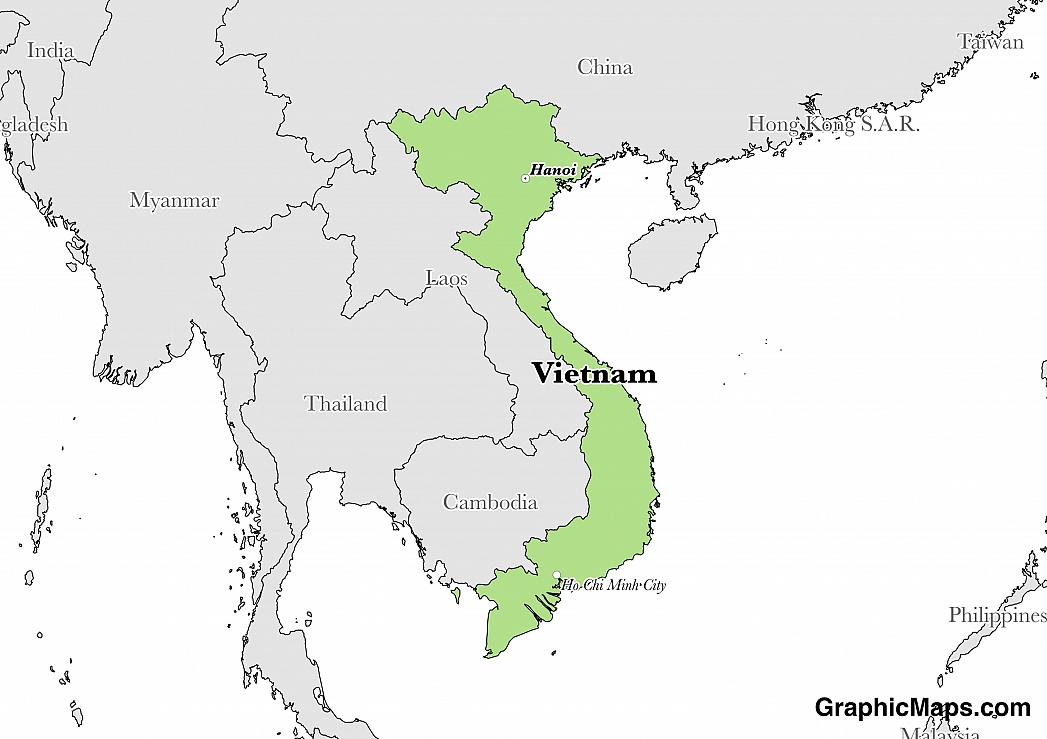Where is Vietnam?
Located in Southeastern Asia, Vietnam has a 4,616.00 km border with Cambodia (1,158 km), China (1,297 km) and Laos (2,161 km). It has a 3,444.00 km coastline. Some southeast states of Vietnam have enhanced border surveillance in order to check for the spread of avian flu.
Hanoi is the capital city of Vietnam and is located in the northern part of the country. From 1010 until 1802, the city served as the political center of the area. The city was also the official capital of French Indochina from 1902-1954. During the Vietnamese Civil War (1954-1976), Hanoi remained the capital city of Northern Vietnam and eventually became the capital of a reunified Vietnam after the North had won the war in 1976. The climate of Hanoi can be classified as a humid subtropical environment, and the country experiences a lot of rainfall. The population of the Hanoi region is currently estimated at 7.6 million people which makes it the second largest region in the country regarding population.
Read more on Vietnam's CapitalVietnam is an Asian country covering 331,210.00 km2 of which 6.38% is water and 310,070.00 km2 is land. Includes more than 80 islands but only about 65 are inhabited. This makes it the 65th largest country in the world and about three times the size of Tennesee; slightly larger than New Mexico. Its geographic coordinates are 16 10 N, 107 50 E and Hanoi is the capital city.
Its name translates into "Viet South".
Its ISO code is VN.
Geography
Vietnam has a mean elevation of 398 m above sea level.
The climate is subtropical with easterly trade winds and relatively low humidity. Its terrain is low, with a flat delta in the south and north, and central highlands and mountains elswhere.
Population
Vietnam has a population of 95,261,021 making it the 14th largest in the world. The majority of the population lives along the South China Sea and the Gulf of Tonkin.
Vietnamese is the official language. The most common ethnic group reported is Kinh (Viet). The majority of the population identifies as non-religious.
The official language of Vietnam is Vietnamese, which is a language that originated in the northern part of the country. The language is part of the Austro-Asiatic family and borrows from Chinese. Minority languages in the country include Cham, Chinese, Khmer, Muong, and Nung to name only a few. The primary foreign language of Vietnam is French and Czech, German, and Russian are also spoken in small communities throughout the country. Over 75 million people in the country speak Vietnamese as their primary or second language. The modern Vietnamese alphabet was created during the 17th century, and exposure to the language increased greatly during the French colonial period. The most common foreign language is French but the economy of Vietnam is heavily reliant on international tourism, and consequently English has become reasonably common in the major tourist areas.
Read more on Vietnam's LanguagesThe dialing code for the country is 84.
Government
Vietnam is an independent country. It gained its independence from France in 1945. Its constitution was last ratified in 2013.
The Vietnamese political system can be defined as a one-party socialist republic in which the President of the country is the head of state, and the Prime Minister is the head of government. Out of the 500 seats in the National Assembly, the Communist Party of Vietnam holds 475, and ultimately, the Communist Party of Vietnam has considerable influence over political activity in the nation. The parliament of Vietnam, known as the National Assembly, is located in the center of the capital city of Hanoi. The current group of representatives in the National Assembly are known as the 14th National Assembly.
Read more on Vietnam's GovernmentEconomy
Factoring in Purchasing Power Parity, Vietnam's GDP is $595,000,000,000.00 (USD) with $6,400.00 (USD) per capita. This makes it the 36th largest economy and its citizens the 155th richest in the world. The currency of Vietnam is the Dong (VND).
Its major export partners are the United States, China, and Japan. Its main exports are clothes, shoes, electronics, and seafood. Its major import partners are China, South Korea, and Singapore. Its major imports include machinery and equipment, petroleum products, and steel products.
Flag
The flag of Vietnam consists of a red banner with a gold star in the center. It was inspired by flags of various communist movements around the world. The 1992 Constitution of Vietnam states that "the National Flag of the Socialist Republic of Vietnam is rectangular in shape. Its width is equal to two-thirds of its length, in the middle of fresh red background there is a bright five-pointed golden star." The red also has a connotation to the spilt blood of those who fought in the name of revolution. The five-pointed star on the flag is representative of the five classes of the Vietnamese population; businessmen, farmers, intellectuals, workers, and military personnel. Previous flags of the nation include the French national flag, the Imperial Japanese flag, and a Southern Vietnamese flag which was used in the southern region of Vietnam from 1948-1976.
Read more on Vietnam's FlagThis page was last modified on January 17th, 2018
More on Graphicmaps

Published on 2019-11-06
What is a Trade Embargo?

Published on 2019-11-04
Which Two Countries Used to Have the Same Flag?

Published on 2019-09-16
What Is the Only Two-Sided State Flag?

Published on 2019-09-16
Which Country Flag Looks Like the Texas Flag?

Published on 2019-08-29
Flags That Resemble the US Flag

Published on 2019-08-20
